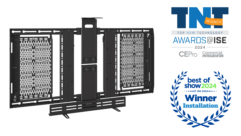Zoned AV Educates the Public About Mercy Corps
It was a rush job, but AV integrator CompView came up with a design for the new Mercy Corps Action Center that took an open space and divided it into discrete, non-intrusive AV exhibits.
CHALLENGE: Under a crazy-tight deadline, design a zoned AV system that confi nes sound to specific areas of an open fl oor plan.
SOLUTION: Create a hybrid approach that combines audio signal processing for the zoned audio with strategically placed directional speakers.
Hey, stuff happens. Pinnacle Exhibits of Hillsboro, Ore., was bidding to work on an installation for the new Mercy Corps Action Center in nearby Portland when it realized that the AV company it had contracted with had dropped the ball. The equipment list Pinnacle had received was mismatched for the project at hand, and there was no AV design to build from.
Mercy Corps, a nonprofit organization devoted to helping people around the world stricken by natural disaster, poverty, and civil conflict, was retrofitting a historic brick building for the purpose of educating the public about its mission and how people could help by volunteering their time or money. AV and interactivity would play a big role
With its bid overdue, Pinnacle Exhibits called on Beaverton, Ore.based integrator CompView to complete the AV design in a weekend. It would have to include touchscreen computers, surround-sound audio, wireless microphones, videoconferencing, and projection systems all within a 3,484-square-foot open layout. The goal was to promote interactivity and engagement, but in a way that no exhibit in the center would interfere with another.
“It’s an open area with a lot of media going on at one time,” says John Cathey, a member of CompView’s systems integration sales team. “[We] had to design and install a very focused system to ensure zones wouldn’t interfere with each other and spill sound throughout the space.”
The team’s bid won. Eight months of building and AV integration and $400,000 later, the Action Center opened to the public.
Zoned AV Educates the Public About Mercy Corps
It was a rush job, but AV integrator CompView came up with a design for the new Mercy Corps Action Center that took an open space and divided it into discrete, non-intrusive AV exhibits.
Visual Aid
Mercy Corps’ Portland Action Center is a sister site to the group’s New York City Action Center. It consists of three mobile training towers, where visitors can watch case studies of region-specific initiatives; eight action stations for calling up information and suggestions about helping out; four video dispatch stations, showing webcam-generated videos of Mercy Corps field staff and beneficiaries; a briefing hut, designed for presentations and videoconferences; and an interactive global status wall at which visitors use touchscreen controls and a Google Earth interface to “spin” the globe and learn about real-time conditions where Mercy Corps is engaged.
“The concept behind the audio-video design was for it to be interactive, so all the video displays have touchscreens except one or two,” says Erin Shannon, CompView’s lead systems designer.
Pressed into action on short notice, the company didn’t throw out the baby with the bathwater: CompView was able to repurpose about half the original equipment list, including seven Elo TouchSystems wall-mounted open-frame, LCD touch monitors, and a 15-inch desktop LCD touch monitorall with acoustic pulse recognition (APR). Elo’s APR technology combines a sturdy glass overlay and small electronic controller board to sense touch through the sound created when people tap, press, or brush the glass a certain way.
Connected to the World
EQUIPMENT LIST
Below is a partial list of the equipment installed by CompView at the Mercy Corps Action Center in Portland, Ore.
- Ashly Audio ne4250pe and ne8250pe amplifiers with CobraNet input modules
- Biamp AudiaFlex CM digital signal processors
- Biamp IP2, OP2e dual-channel input/output cards
- Biamp AEC-2HD dual-channel echo-cancellation input cards
- Boston Acoustics SoundWare speakers
- Brown Innovations Maestro focused display speaker
- Chief CMA-110, RPA-U projector mounts
- Chief PCS-2124 ceiling display mounts
- ClockAudio C33E SR RF gooseneck microphones
- Crestron Electronics CP2E compact controller
- Crestron Electronics MP2E networked controllers
- Crestron Electronics TPS-6L in-wall touch panels
- Dakota Audio MA-5 focused-array loudspeakers
- Devantech SRF05 occupancy sensors
- Eaton IPC3400-A1-NET Intelligent Power Controllers
- Elo TouchSystems 1522L, 1739L, and 1939L touchscreens
- Extron Electronics SMX 400 MultiMatrix switcher
- Extron Electronics MTP T 15HD A transmitters
- Extron Electronics MTP RL 15HD A receivers
- Hitachi CP-A100 ultrashort-throw projectors
- JBL Professional Control 26c in-ceiling speakers
- Lenovo ThinkCentre M58p workstations
- Middle Atlantic PTRK-2726 27-RU rolling rack
- Peerless SA740P and SF630 LCD mounts
- Radio Design Labs FP-MX4 four-channel mini mixers
- Samsung 400UX LCD displays
- Shure ULXS14/50 wireless microphone systems
- SpeakerCraft AIM Cinema Three in-wall speakers
- SpeakerCraft ASM67120 subwoofer
- TV One 1T-C2-400 video processor/scalers
Source: Pinnacle Exhibits
The briefing hut, which was built of reclaimed wood, contains one of two Hitachi CP-A100 ultrashort-throw projectors, and is used for presentations to visiting school groups and other visitors. There’s a lectern with its own touchscreen computer, webcam, and microphone system, plus a connection panel for launching the center’s portable LifeSize videoconferencing system.
The second Hitachi projector displays Mercy Corps’ custom-programmed Google Earth exhibit on the global status wall. From a custom-built podium designed by Pinnacle Exhibits, visitors can operate the wall and spin a globe by swiping their hand to the left or right on the touchscreen. They can then select a predesignated location to learn more about Mercy Corps’ efforts in that area.
Neither Hitachi projector displays on an actual screen, but rather on a section of wall that Pinnacle Exhibits treated with projection-screen paint. Both projectors ride the facility’s AV network. If the global wall isn’t being used, or there’s overflow from the briefing hut during a videoconference, the LifeSize output can be routed to the second projector. In fact, video can be routed to any screen or monitor in the space in an one-to-all or one-to-one fashion. An Extron SMX 400 MultiMatrix switcher provides the brains, along with a collection of Extron MTP twisted-pair transmitters and receivers for moving VGA, audio, and RS-232 signals.
Although Mercy Corps relies on interactive video to educate visitors, the star of this Action Center’s AV design may be the audio system.
“We have five zones set up, using in-ceiling speakers, and then we have maybe 15 potential audio and video sources,” explains Jesse Mejia, the Action Center’s technical specialist, who operates the system. “So video and audio can be routed together or independently. Audio can be routed to any of those five zones or any of the exhibits that have audio dedicated to them.”
Zoned AV Educates the Public About Mercy Corps
It was a rush job, but AV integrator CompView came up with a design for the new Mercy Corps Action Center that took an open space and divided it into discrete, non-intrusive AV exhibits.
Mejia calls the design a “hybrid” of a traditional zoned system and more focused, standalone audio destinations. “I think that works really well, because we definitely need the flexibility to have the zones still be separate from those exhibits.”
Overall, the hybrid audio system represents a mix and match of different speaker types. For instance, throughout the Action Center CompView and Pinnacle Exhibits integrated four JBL Control 26c in-ceiling loudspeakers, a pair of SpeakerCraft AIM Cinema Three in-wall loudspeakers, a SpeakerCraft ASM67120 subwoofer, 14 Boston Acoustics SoundWare speakers, and three Soundtube RS500i open-ceiling hanging loudspeakers.
For the tower and station exhibits, where it was important to localize the sound, the design team employed various Dakota Audio MA-5 focused mini-array loudspeakers in different lengths depending on the screens they accompanied, plus two Brown Innovations Maestro display speakers.
The backbone of the system is a pair of Biamp AudiaFlex CM processors running CobraNet and a slew of Biamp IP2 dual-channel input cards and OP2e output cards. And to help keep the sound under control and enhance conferencing sessions, the system includes a handful of Biamp AEC-2HD echo-cancelling input cards. CompView designed a Biamp daVinci control screen interface into the Action Center’s overall Crestron control system to make managing the experience easy from a pair of Crestron TPS-6L in-wall touch panels.
“We used Crestron’s control system with a Biamp daVinci page for advanced audio operations, and the end result was the [staffers] that come in to work for a day, they can walk in and use the space,” CompView’s Shannon says. “It’s very intuitive and easy to operate.”
Power Down
Of course, no good AV design goes unchallenged. Just when Shannon and team thought everything was coming together, CompView received some bad news. The custom power-distribution system it ordered for the Action Center’s opening was late. In keeping with the goal of ease-of-use, CompView wanted to install networked management. Because many of the exhibits are PC-basedoften driven by network computers at an off-site locationthe designers wanted each source tied to a reset button in the Action Center. That way, according to Shannon, if one of the sources froze or crashed, an operator could reboot it from a panel without going into the equipment room or calling off-site.
CompView set up a temporary power distribution system to last until the custom system arrived a couple months after the center’s grand opening.
Today, Mejia and his staff are happy with what CompView came up with in such short notice. “The routing flexibility is really what does it for me,” he says. “You can go in and actually route anything that’s connected to anything else. It’s the thing I’m most thankful about as a technical user.”
Kimberly R. Griffin is a technical writer for AOL and freelance contributor to Pro AV.










